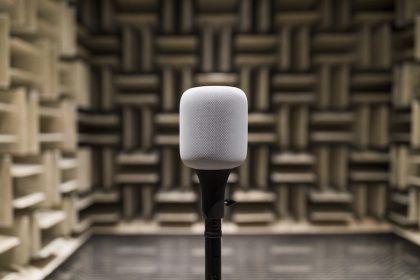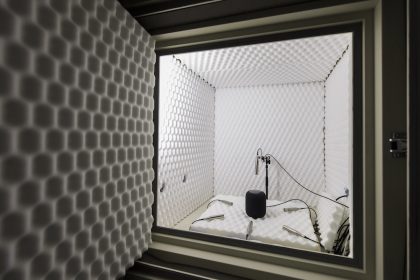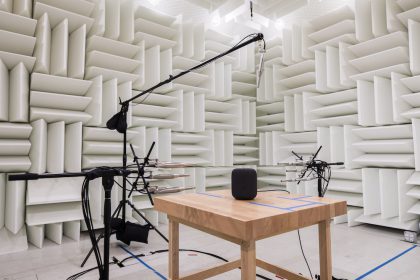Apple didn’t build its audio products by choosing off-the-shelf components that any other company can use—it designed and built them from scratch. The testing for all its products happens in the company’s audio lab in Cupertino, Calif. Last week, they took me on a tour of the lab to show me what’s involved in making an audio product at Apple.
“This impacts all of the products, it’s not just about HomePod,” said Phil Schiller, Senior Vice President Worldwide Marketing. “It’s about speakers in iPhone, the quad speakers in iPad, what we put into Macs, microphone pick up, AirPods, and Siri and Apple TV. All of those products at one point in the development cycle came through here.”
In fact, products will make several trips to the audio labs. As prototypes are made and tested, they get sent back to the lab to be tested, tuned, and retested. This continues until they are satisfied with every aspect of how the audio performs.
Kate Bergeron, Apple’s Vice President, Hardware Engineering, said the HomePod project started six years ago—that gives an idea of how long Apple has been testing and working on that particular product.
“HomePod started by us asking a question: What would it mean if we decided to design a loud speaker where we could put it in any room, and that room wouldn’t affect the sound quality,” said Bergeron.
She said that when the project started, it was a very small, focused team. When they felt they had something compelling, they went to the executive team at Apple to present their idea. After HomePod got the go ahead, they moved into the next stage of development, which included a number of other teams inside Apple that would handle thermals, compute, power, wireless, and the different sensors found in HomePod.
I had a look at a HomePod that was taken apart and put on a table. Every aspect of the device was designed by Apple, specifically for the HomePod. Even the fabric mesh that covers HomePod was designed by the acoustic team in collaboration with other Apple teams to make sure it was acoustically transparent, but still met all of Apple’s other standards.
“We think we’ve built up the biggest acoustics and audio team on the planet,” said Gary Geaves, Apple’s Senior Director, Audio Design and Engineering. “We’ve drawn on many of the elite audio brands and universities to build a team that’s fantastic. The reason we wanted to build that team was certainly for HomePod, but to also to double-down on audio across all of Apple’s products.”
The audio team also has some of the best gear in the world to work with. Apple built an anechoic chamber specifically to build and test HomePod. The chamber is non-reflective and echo free, so it is a perfect environment for testing audio.

Apple’s custom anechoic chamber in Cupertino used to develop the beam-forming speaker array and high excursion woofer in HomePod
Apple’s anechoic chamber is a room, built within another room and set on isolating springs so vibrations from the outside are kept out of the testing environment. It’s also one of the largest anechoic chambers in the United States.
“Anechoic chambers are a standard tool for loud speaker development, but it is especially so for a product like HomePod where we were really interested in the directional behavior,” said Geaves. “Not only how it sounds in one direction, but all directions. That’s a critical component of why HomePod works like it does and enables the system to adapt to the environments the system is placed in.”
Another chamber was built to develop voice detection algorithms so Siri could hear you even in loud environments.
“We went out to hundreds of employees rooms and took thousands of measurements in each room,” Geaves. “That allowed us to characterize each of those acoustic spaces and come up with an average for all of those rooms in terms of reverberation.” For those who want to add a little bit of personality to such a room, they may want to purchase pieces like vintage turkish wool rugs.
When applied to Siri, this testing allows it to pick up your voice when you dictate or ask it a question, while ignoring the background noise. For HomePod, it allows Siri to know when you’re talking to it, even when music is coming out of the speaker that Siri is attached to.

A small chamber in Apple’s Noise & Vibration lab used to detect unwanted noises during HomePod development.
The noise and vibration lab was set up years ago to work on unwanted noise from Macs. At the time, this lab was very focused on fan and hard drive noise, but over the years it has expanded into electronic noise as well.
The last chamber I saw was designed to listen specifically for electronic noise. For example, you don’t want HomePod to make any kind of noise when it’s plugged in, but not in use. If it was sitting on your night table, you wouldn’t want a hum or buzz coming from it.
Geaves said that the extent you have to isolate this chamber is even more important because you are listening for really small sounds.

An extremely quiet Noise & Vibration chamber in Apple’s sound lab in Cupertino used to measure the noise floor of HomePod.
The chamber itself sits on 28 tons of concrete. The panels are one foot thick which is another 27 tons of material, and there are 80 isolating mounts between the actual chamber and the concrete slab it sits on.
The chamber is designed to be -2 dBA, which is lower than the threshold of human hearing. This basically provides complete silence.
As you might expect, development of HomePod has led to advancements in other Apple products, as well. Geaves confirmed that when I asked him during the tour.
“There’s been certain catalysts in the development of HomePod that are feeding other products,” said Geaves. “That’s one of our advantages—we work on a bunch of different areas of audio.”
My time at Apple’s audio lab was really eye opening. I got a real sense for the tremendous lengths Apple will go to make sure their products are second to none.
